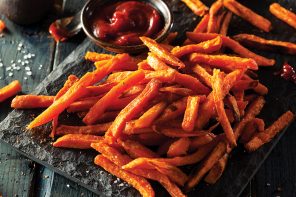Just cook one more night a week. That’s the mission Melissa Clark has for her readers.
“If you’re already cooking once a week and maybe you are ordering in the rest of the time, I want you to cook twice a week,” Clark said during a recent talk at Barnes & Noble’s concept store in Eastchester. “Even if you’re just cooking once a month, I want you to make that jump to twice a month.”
For the crowd that filled the store’s lobby, it was likely not the first time they’ve received cooking advice from Clark. She writes the popular weekly “A Good Appetite” column for The New York Times, for which she also appears in weekly cooking videos, and has written or co-written dozens of cookbooks.
Safe to say, she’s an authority on good eating. Still, she recognizes that even a seemingly modest request, such as one more night of cooking a week, can be easier said than done.
“Even people who love to cook on the weekends become overwhelmed during the week,” she said. “They say, ‘Oh my God, dinner, again? I have to make dinner again?’”
Clark’s latest cookbook, “Dinner: Changing the Game,” published in March, attempts to break through the barriers — a lack of free time or inspiring ideas, even intimidation — that prevent people from cooking. The book offers a huge range of inventive dishes, but Clark said the actual cooking methods should be approachable for anyone.
“I always say that this book is all about simple techniques,” Clark told WAG. “All the recipes are familiar, like roast chicken, seared steak, but the flavors are different. That’s where I can help people sort of change it up.”
The book offers more than 200 recipes total, ranging from chorizo pork burgers to maple-roasted tofu to butternut squash pizza. Dishes “designed to help you figure out what to make for dinner without falling back on what you’ve eaten before,” Clark writes in the book.
In the introduction, Clark describes a gap between what people want to eat when they are out at restaurants and what people are willing to cook at home. Home meals, she writes, are still caught in the old-fashioned approach to meal planning — “a protein and two sides.”
While people are willing to try new things at a restaurant, Clark said, they’re a little more cautious at home.
“When you’re cooking for your family, you have to say, ‘OK, is my kid going to eat this?’” she said. “‘Is my husband going to eat this?’ And so it is riskier, and I think it’s harder for people to take that step.”
Recipes in the new cookbook incorporate diverse ingredients, such as kimchi, quinoa and pork belly, into “one-pot” meals that help home cooks escape the “tyranny of a perfectly composed plate with three distinct elements in separate little piles,” as she writes in the introduction.
Clark said she’s always looking for new ingredients to introduce to her readership and is quick to embrace whatever is trendy.
“I jump on all the bandwagons,” Clark said. “I’m like, ‘kimchi, cool. Pomegranate molasses, I’m there.’ If there is a new ingredient flying around, I am there.
“You need somebody to be the intermediary between gochujang, which is this amazing Korean red pepper paste I’m absolutely obsessed with,” she added. “I write a recipe for it and then people start to ask in the supermarket for it, then they start to stock it and people get it. So that chain has to start somewhere and I’m happy to be part of it. I’m happy to just help people get more interesting ingredients and make their dinners a little more exciting.”
Clark grew up in Brooklyn, where she still lives with her husband and daughter. Growing up, her parents would “do the Julia Child thing,” as she described it, and cook elaborate meals and invite friends over for dinner parties.
That established her love for food that would eventually pair with a passion for writing, which she said she has been doing for as long as she could hold a pen.
“As I was writing stories, food was always my metaphor,” she said. “It was my lens for how I saw the world.”
She graduated with an MFA in writing from Columbia University and left college at what she said was the “right place, right time,” to pursue a career as a food writer. It was the mid-1990s and publications were just starting to migrate over to internet publishing.
“These companies were getting their feet wet and trying it out,” Clark said. “They needed to fill the space and I needed a place to write about what I wanted to write about. So it was a great opportunity.”
The more she wrote, the more opportunities opened up. She said she was an automatic “yes” whenever contacted by an editor for freelance work. That attitude led to her first published cookbook.
“Someone came to me and said, ‘Do you want to write a bread-machine cookbook in six weeks?’” Clark recalled. “I’d never written a cookbook in my life. I’d never used a bread machine in my life. But I said, ‘Yeah, I’ll figure it out.’”
It took four bread machines running 24 hours a day, but Clark managed to put together 200 bread recipes in six weeks.
She began freelancing for The New York Times in 1998 with a column that answered readers’ cooking questions. Her “A Good Appetite” column started in 2007. She became a staff writer in 2012.
She’s written 38 cookbooks total, including collaborations with such well-known chefs such as Daniel Boulud, Claudia Fleming, David Bouley and Bill Yosses. She has no official tally, but estimated that she’s written at least a couple thousand recipes.
That’s a process that involves constant refining. A particularly tricky banana blondie recipe for The Times took more than 20 different iterations before publishing. “I’d bring them into work and my editor would be like, ‘They’re fine, stop,’” Clark said. “And I’d say ‘No.’ I had this vision in my head and I was like, ‘No, they’re not that.’”
One of her favorites from “Dinner” is a spatchcocked (split open) roasted chicken with grapes. The grapes are drizzled with vinegar and provide a bright background for the chicken.
“It’s like fancy company food, except that you can make it on a weeknight in under an hour,” Clark said.
For good summer meals, she recommends a pork chop with peaches recipe from the book. “Peaches come into season in July, so that will be perfect.” Or, “if you want to eat peaches and you don’t want to turn your oven on,” there’s a burrata salad that incorporates peaches as well.
The most famous recipe in the book may be the guacamole with peas dip. That title should sound at least vaguely familiar to anyone with a Twitter account. Clark published it in a column in 2013, based on a dish served at chef Jean-Georges Vongerichten’s Manhattan restaurant ABC Cocina.
The recipe didn’t draw a ton of attention until two years later, when The Times’ Twitter account pulled it from the archives and tweeted a link to it. The tweet said, “Add green peas to your guacamole. Trust us.” The suggestion was pounced on by thousands of angry or sarcastic respondents, deriding the twist on the beloved dish. Even President Barack Obama weighed in, tweeting: “respect the nyt, but not buying peas in guac. onions, garlic, hot peppers. Classic”
Clark said she was at the doctor’s office that day when her Twitter account started to explode with notifications. “I got back to the office and I’m just like, ‘What’s going on?’” Clark said.
While she admitted being a bit bothered at the time to see one of her columns so maligned, she stands by the recipe. There’s enough room in the world for all kinds of guacamole, Clark said, and it’s good to try new things.
“People should have an open mind. And they should try things before they decide they like them or not. And I say the same with my kid. I say ‘Try it. Try it.’”






